 W
WA projector or image projector is an optical device that projects an image onto a surface, commonly a projection screen. Most projectors create an image by shining a light through a small transparent lens, but some newer types of projectors can project the image directly, by using lasers. A virtual retinal display, or retinal projector, is a projector that projects an image directly on the retina instead of using an external projection screen.
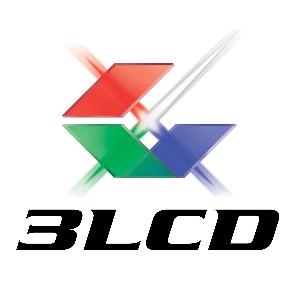 W
W3LCD is the name and brand of a major LCD projection color image generation technology used in modern digital projectors. 3LCD technology was developed and refined by Japanese imaging company Epson in the 1980s and was first licensed for use in projectors in 1988. In January 1989, Epson launched its first 3LCD projector, the VPJ-700.
 W
WThe Bioscop is a movie projector developed in 1895 by German inventors and filmmakers Max Skladanowsky and his brother Emil Skladanowsky (1866–1945).
 W
WThe Brenkert Brenograph Jr. was a projector used in atmospheric theatres to project moving clouds over ceilings painted blue. The effect created the illusion that theatre patrons were outdoors. The device was used primarily in theatre designs of John Eberson.
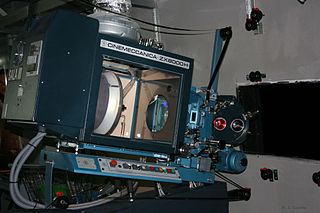 W
WCinemeccanica is a motion picture equipment company specializing in cinema projectors. The company was formed in 1920 in Milano, Italy. Currently they have two film projectors available, the Victoria 5 and the Victoria 8. A new digital projector, the CMC3 D2 is also available.
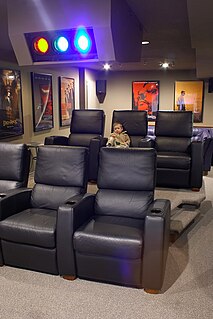 W
WA CRT projector is a video projector that uses a small, high-brightness cathode ray tube as the image generating element. The image is then focused and enlarged onto a screen using a lens kept in front of the CRT face. The first color CRT projectors came out in the early 1950s. Most modern CRT projectors are color and have three separate CRTs, and their own lenses to achieve color images. The red, green and blue portions of the incoming video signal are processed and sent to the respective CRTs whose images are focused by their lenses to achieve the overall picture on the screen. Various designs have made it to production, including the "direct" CRT-lens design, and the Schmidt-CRT, which employed a phosphor screen that illuminates a perforated spherical mirror, all within an evacuated "tube."
 W
WDigital Light Processing (DLP) is a set of chipsets based on optical micro-electro-mechanical technology that uses a digital micromirror device. It was originally developed in 1987 by Larry Hornbeck of Texas Instruments. While the DLP imaging device was invented by Texas Instruments, the first DLP-based projector was introduced by Digital Projection Ltd in 1997. Digital Projection and Texas Instruments were both awarded Emmy Awards in 1998 for the DLP projector technology. DLP is used in a variety of display applications from traditional static displays to interactive displays and also non-traditional embedded applications including medical, security, and industrial uses.
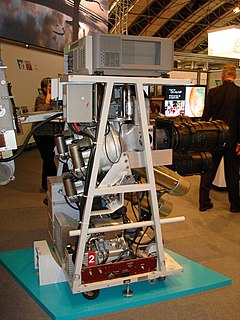 W
WAn Eidophor was a television projector used to create theater-sized images from an analog video signal. The name Eidophor is derived from the Greek word-roots eido and phor meaning 'image' and 'bearer' (carrier). Its basic technology was the use of electrostatic charges to deform an oil surface.
 W
WA handheld projector is an image projector in a handheld device. It was developed to as a computer display device for compact portable devices such as mobile phones, personal digital assistants, and digital cameras, which have sufficient storage capacity to handle presentation materials but are too small to accommodate a display screen that an audience can see easily. Handheld projectors involve miniaturized hardware, and software that can project digital images onto a nearby viewing surface.
 W
WThe keystone effect is the apparent distortion of an image caused by projecting it onto an angled surface. It is the distortion of the image dimensions, such as making a square look like a trapezoid, the shape of an architectural keystone, hence the name of the feature. In the typical case of a projector sitting on a table, and looking upwards to the screen, the image is larger at the top than on the bottom. Some areas of the screen may not be focused correctly as the projector lens is focused at the average distance only.
 W
WAn LCD projector is a type of video projector for displaying video, images or computer data on a screen or other flat surface. It is a modern equivalent of the slide projector or overhead projector. To display images, LCD projectors typically send light from a metal-halide lamp through a prism or series of dichroic filters that separates light to three polysilicon panels – one each for the red, green and blue components of the video signal. As polarized light passes through the panels, individual pixels can be opened to allow light to pass or closed to block the light. The combination of open and closed pixels can produce a wide range of colors and shades in the projected image.
 W
WMotiograph was a film equipment company established by Alvah C Roebuck in Chicago in 1896. The company manufactured theater projectors and speakers. Their Optiograph 35 mm film projector was first introduced in 1898 and sold via catalogs including Sears. This was a smaller projector suitable for homes and schools. Beginning in 1908, all products released by the Enterprise Optical Manufacturing Company carry the brand name Motiograph. In 1911, their first theater grade 35 mm projector was released. Roebuck sold the company in 1924 to a group of investors led by O.F. Spahr and Fred Matthews who would become the new President and Secretary, respectively. The Matthews family would retain ownership from then on. In 1936, they change the company name from the Enterprise Optical Manufacturing Company to become Motiograph, Inc. Also in 1936, Motiograph releases the very popular model K projector and continues to innovate after the war years. The date of the company's closure is unverified, but by 1969 it had failed to renew any copyrights for its products. The last corporate listing for Motiograph in Illinois is from 1973.
 W
WA movie projector is an opto-mechanical device for displaying motion picture film by projecting it onto a screen. Most of the optical and mechanical elements, except for the illumination and sound devices, are present in movie cameras. Modern movie projectors are specially built video projectors.
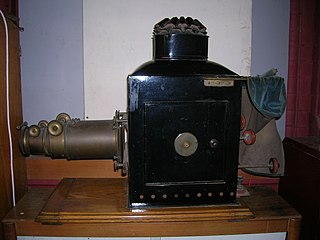 W
WThe opaque projector, epidioscope, epidiascope or episcope is a device which displays opaque materials by shining a bright lamp onto the object from above. A system of mirrors, prisms and/or imaging lenses is used to focus an image of the material onto a viewing screen. Because they must project the reflected light, opaque projectors require brighter bulbs and larger lenses than overhead projectors. Care must be taken that the materials are not damaged by the heat generated by the light source. Opaque projectors are not as common as the overhead projector.
 W
WAn overhead projector (OHP), like a film or slide projector, uses light to project an enlarged image on a screen, allowing the view of a small document or picture to be shared with a large audience.
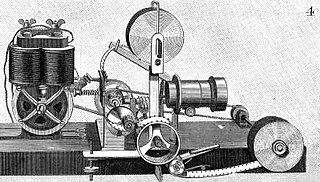 W
WThe Phantoscope was a film projection machine, a creation of Charles Francis Jenkins and Thomas Armat. In the early 1890, Jenkins began creating the projector. He later met Thomas Armat who provided financial backing and assisted with necessary modifications The two inventors unveiled their modified projector at the Cotton States Exposition in Atlanta, Georgia, in September 1895.
 W
WThe Polylux was an overhead projector produced in the German Democratic Republic (GDR). It also functioned as a generic name for overhead projectors in the GDR.
 W
WAn optical comparator or profile projector is a device that applies the principles of optics to the inspection of manufactured parts. In a comparator, the magnified silhouette of a part is projected upon the screen, and the dimensions and geometry of the part are measured against prescribed limits. It is a useful item in a small parts machine shop or production line for the quality control inspection team.
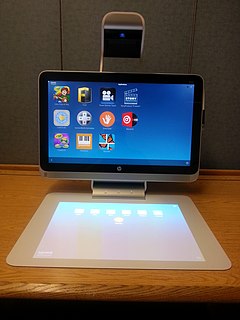 W
WProjector-camera systems (pro-cam), also called camera-projector systems, augment a local surface with a projected captured image of a remote surface, creating a shared workspace for remote collaboration and communication. Projector-camera systems may also be used for artistic and entertainment purposes. A pro-cam system consists of a vertical screen for implementing interpersonal space where front-facing videos are displayed, and a horizontal projected screen on the tabletop for implementing shared workspace where downward facing videos are overlapped. An automatically pre-warped image is sent to the projector to ensure that the horizontal screen appears undistorted.
 W
WTalaria was the brand name of a large-venue video projector from General Electric introduced in 1983.
 W
WR. W. Paul presented Britain's second film projector, and the first commercially produced 35mm projector, the Theatrograph, on 20 February 1896. It was first demonstrated at Finsbury Technical College. The use of Paul's Theatrograph in music halls up and down the country popularised early cinema in Britain. It was first revealed to the public at the Egyptian Hall in Piccadilly, London.
 W
WIn film terminology, throw is the distance between a movie projector lens and its screen. It is the distance the image is thrown onto the screen, and it has a large effect on screen size. Home theatre installations may often have an incorrect throw distance in the room but this can be corrected by use of a short throw lens. There are also "long throw" lenses available.
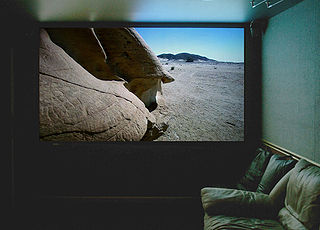 W
WA video projector is an image projector that receives a video signal and projects the corresponding image on a projection screen using a lens system. Video projectors use a very bright Ultra-high-performance lamp, Xenon arc lamp, LED or solid state blue, RB, RGB or remote fiber optic RGB lasers to provide the illumination required to project the image, and most modern ones can correct any curves, blurriness, and other inconsistencies through manual settings. If a blue laser is used, a phosphor wheel is used to turn blue light into white light, which is also the case with white LEDs. A wheel is used in order to prolong the lifespan of the phosphor, as it is degraded by the heat generated by the laser diode. Remote fiber optic RGB laser racks can be placed far away from the projector, and several racks can be housed in a single, central room. Each projector can use up to two racks, and several monochrome lasers are mounted on each rack, the light of which is mixed and transmitted to the projector booth using optical fibers. Projectors using RB lasers use a blue laser with a phosphor wheel in conjunction with a conventional solid state red laser.
 W
WVitascope was an early film projector first demonstrated in 1895 by Charles Francis Jenkins and Thomas Armat. They had made modifications to Jenkins patented Phantoscope, which cast images via film and electric light onto a wall or screen. The Vitascope is a large electrically-powered projector that uses light to cast images. The images being cast are originally taken by a kinetoscope mechanism onto gelatin film. Using an intermittent mechanism, the film negatives produced up to fifty frames per second. The shutter opens and closes to reveal new images. This device can produce up to 3,000 negatives per minute. With the original Phantoscope and before he partnered with Armat, Jenkins displayed the earliest documented projection of a filmed motion picture in June 1894 in Richmond, Indiana.